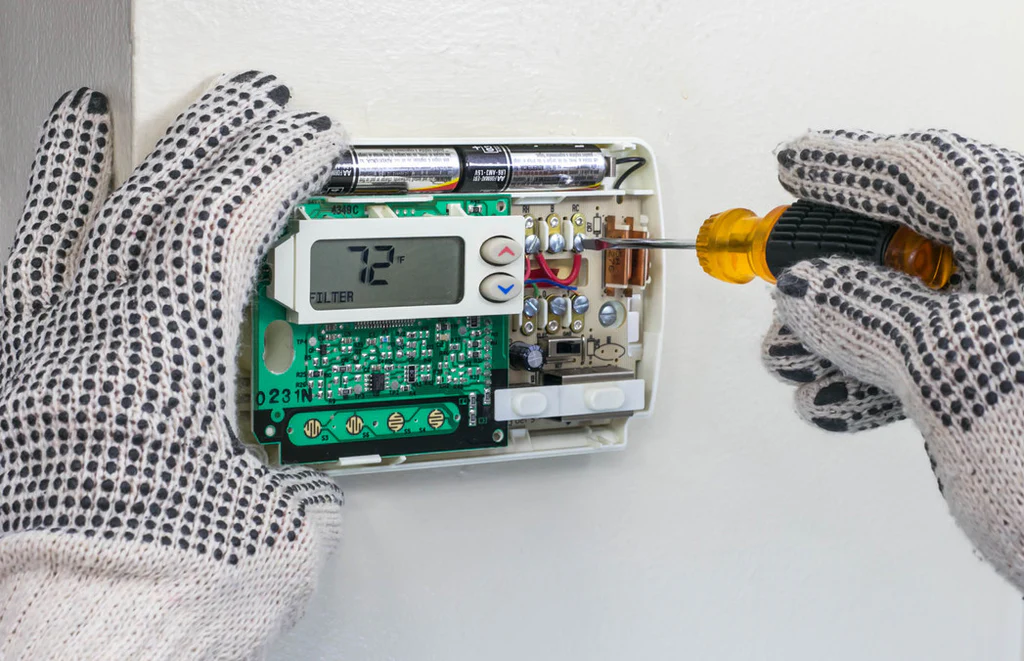A thermostat that goes blank and then comes back on can be more than just an inconvenience; it can signal underlying issues that need to be addressed to maintain comfort and efficiency in your home. This article explores common causes for this problem and provides practical steps for troubleshooting and fixing it.
Common Causes of a Blank Thermostat
Power Issues
Power interruptions are a primary cause of thermostat goes blank then comes back on. These interruptions can be due to power outages, tripped circuit breakers, or issues with the HVAC system’s power supply.
Low or Dead Batteries
Many thermostats rely on batteries for power. If the batteries are low or dead, the display can go blank. This is an easy fix but is often overlooked.
Loose or Damaged Wiring
Wiring issues can cause intermittent power loss to the thermostat. Loose, frayed, or damaged wires can disrupt the electrical connection, leading to the thermostat going blank.
Faulty Thermostat
Sometimes, the thermostat itself may be faulty. Age, manufacturing defects, or internal malfunctions can cause the display to go blank.
HVAC System Problems
Issues within the HVAC system, such as a malfunctioning transformer or blower motor, can also affect the thermostat’s power supply, leading to a blank display.
Software Glitches
In programmable or smart thermostats, software glitches can cause the display to go blank. These issues may require a reset or firmware update.
Troubleshooting Steps
Check the Power Source
Ensure that the thermostat is receiving power. Check for tripped circuit breakers or blown fuses in your home’s electrical panel. Reset any tripped breakers and replace any blown fuses.
Replace the Batteries
If your thermostat uses batteries, replace them with fresh ones. Ensure the batteries are properly installed and that the battery contacts are clean.
Inspect Wiring Connections
Turn off the power to your HVAC system and remove the thermostat cover. Check for loose, frayed, or damaged wires. Secure any loose connections and repair or replace damaged wires as needed.
Reset the Thermostat
Resetting the thermostat can resolve software glitches. Refer to your thermostat’s manual for reset instructions. This often involves pressing a reset button or removing the batteries for a few minutes.
Update Firmware
For smart thermostats, check if there are any available firmware updates. Follow the manufacturer’s instructions to update the firmware, which can resolve software-related issues.
Test the HVAC System
Check if the HVAC system is functioning properly. Listen for unusual noises and ensure that the blower motor and other components are operating correctly. If there are issues within the system, it may require professional repair.
When to Call a Professional
Persistent Issues
If the thermostat continues to go blank despite troubleshooting, it’s time to call a professional. Persistent issues may indicate complex problems that require expert diagnosis and repair.
Electrical Problems
Electrical issues, such as faulty wiring or problems within the HVAC system, should be addressed by a qualified technician. Attempting to fix electrical problems without proper training can be dangerous.
Thermostat Replacement
If the thermostat itself is faulty and cannot be repaired, a professional can help you select and install a new thermostat that meets your needs.
Preventive Maintenance Tips
Regular Battery Replacement
Replace thermostat batteries every six months to ensure a constant power supply. Mark your calendar to remind you of this simple but essential maintenance task.
Routine HVAC Inspections
Schedule regular HVAC inspections and maintenance to ensure all components are functioning correctly. This can prevent power-related issues that affect the thermostat.
Secure Wiring Connections
Periodically check wiring connections for signs of wear or damage. Secure any loose connections and replace damaged wires to maintain a stable power supply to the thermostat.
Stay Updated
For smart thermostats, regularly check for firmware updates. Keeping the software up to date can prevent glitches and improve performance.
Conclusion
A thermostat that goes blank and then comes back on can be caused by various issues, from simple battery problems to more complex electrical or HVAC system malfunctions. By understanding the common causes and following the troubleshooting steps outlined above, you can often resolve the issue yourself. However, don’t hesitate to call a professional for persistent problems or if you’re uncomfortable handling electrical components. Regular maintenance and timely professional assistance can ensure your thermostat and HVAC system operate smoothly, keeping your home comfortable year-round.
